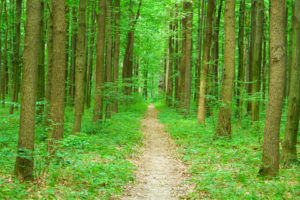By Blair McKissock, MSEd, RYT
As we enter into the New Year, we spend quite of bit of energy thinking of goals we want to set, new directions we want to go in, or new adventures we want to embark on. The resolutions have a nasty habit of moving to the back burner soon after setting them, as we get swept back into the current of life. This year, make a resolution that will have a greater influence on your overall well-being by reconnecting with the natural world. Just getting outside, breathing air that flows between trees, and not buildings, can have a profound effect on our entire mind, body and spirit. Especially in a world where we spend more time connecting to electronics, and less time connecting with time, connecting to each other, and connecting with our inner selves. According to the World Wildlife Federation, spending time outdoors in nature can increase fitness levels, and therefore decrease your risk for certain diseases. There is also evidence that being outdoors can improve your distance vision, reduce the symptoms of ADHD, depression, and anxiety! Wow, stepping outside is so much easier than going to the gym. This might just be the resolution you keep. Here are some other ways you can experience the benefits of connecting with nature this year:
- Incorporate green friends into your home décor – So even if you don’t spend much time outside, you can still connect with nature by bringing the outdoors in. Many studies show that having houseplants can improve your air quality and reduce stress. Start with low maintenance varieties like an indoor evergreen, potted ivy or philodendron. Ask your local greenhouse for suggestions. Take the time to connect with your new housemates by paying a little closer attention to their cycles and rhythms for watering, for example.
- 30 minutes a day – I don’t mean exercise…. Just 30 minutes of sunlight a day can have tremendous health benefits, including boosting metabolism, decreasing depression, improving sleep, and it has even been shown to have a positive effect on the symptoms of Alzheimer’s disease. The sun is at the core of our cycles, seasons, our food, our existence. Connect with it as you bask in it. Just turn your face toward the sun, eyes closed of course, and soak in the goodness.
- Get a little dirty – Ok, not that kind of dirty, I’m talking hands in the dirt, mud-pie dirty. The National Institutes for Health and other organizations agree that getting dirty is good for you. Children who have the chance to get a little dirty have more effective immune systems. Other studies have shown that getting your hands in the dirt can also expose your body to the good kinds of bacteria, and can boost your mental health. I wonder if that means I don’t have to work so hard at keeping my house clean?
- Go ahead, hug a tree – Yes, it might sound cliché yet maybe the hippies were right about something. In our culture, we tend to engage in a deeper relationship with our electronics than other humans. This lack of connection impacts us in all areas of our lives and makes it harder to connect with others, let alone have a functional relationship with another person. Yes, let’s face it, Siri doesn’t argue. If we can settle our mind, and physically connect through touch with another living creature, we begin to open ourselves up. Physical touch can be such a transformative and powerful experience. Take the time to mindfully notice what you feel and smell; use all of your senses to create that connection. So start with something easy like a tree. It won’t argue either, and it just feels good to give them a big hug.
- Forget conscious uncoupling, try conscious connecting – Have you ever walked into a park or wooded area and felt how the energy changed? Sometimes more undisturbed natural areas have a bit of a different feel to them, like they have their own personality. In the practice of ecopsychology, there is a lot of discussion about how we connect consciously to the world around us. It’s almost like creating a conscious relationship with nature. In the start of any relationship, we might introduce ourselves. So take that same idea and apply it when you enter into a relationship with nature. This can be as simple as asking permission to connect, and waiting to see if you get a response. Try it when you take a walk in a park or go hiking. As you spend time in the space, try to consciously connect with specific things in the space that draw your attention, like a bird or a creek. See if it doesn’t intensify the well-being you feel while you are in the space. Oh, don’t forget to be polite and say thank you when you leave.
- Take a deep breath – Those yogis were right when they said that life is breath, and breath is life. Next time you step outside take a deep breath and notice the quality of air in different spaces. Compare your breathing when you are in a more populated area, versus the way you breathe when surrounded by the natural world. When we are in an open area with more undisturbed terrain, you tend to feel bigger, more open, and the breath reflects that. Our body recognizes the clean air and pulls it deep into the lungs. Atoms in the air do not die to disperse. As one being takes the atoms of the air in and exhales them, another being takes them in and exhales. So when you take a breath in, notice that this is the same air that a tree took in, cleaned, and put back out. It is the same air taken in by a person from the past, it nourished their body, and now it nourishes yours. It’s a bit of a mind trip of a concept, yet it drives home the feeling of being connected on a much deeper level.
Man’s connection with nature is at the core of the decisions we make in our daily life and how we approach the world. When we truly realize that connectedness we might look upon our fellow man with more compassion, and we might also think differently about how we treat the earth we live on. A deeper connection might invoke more feelings of gratitude for the earth that sustains us. We don’t have to resolve to change the world; just resolve to take a few minutes each day to connect to it. If we took that time, who knows, collectively we might just change the world.
Blair McKissock, MSEd, RYT is a speaker and author on experiential and nature-based learning. Learn more about coaching, OmHorse Yoga as well as upcoming equine assisted workshops at stridestosuccess.org.
 Conscious Community Magazine Dedicated to Elevating Consciousness
Conscious Community Magazine Dedicated to Elevating Consciousness





